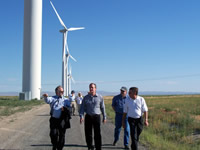Renewable and Alternative Energy
|
Idaho, a pioneer in the field of what has traditionally been called alternative energy, has already answered one challenge presented by the President.
Starting with nuclear power over fifty years ago, the Idaho National Lab sets the standard for cutting edge nuclear research and development. Idaho's universities and colleges are engaged in important ethanol research and developing fuel from biomass and wind farms are being established. These are all renewable resources.
Idahoans, particularly agri-business, know the detrimental effect of high energy costs on business viability and profitability. Substantially reducing fossil fuel dependence demonstrates a commitment to security, affordable energy and a healthier environment.
 |
Senator Crapo takes a walking tour of Fossil Gulch Wind Park in Hagerman. |
My committee assignments give me an opportunity to help craft our nation's efforts regarding alternative energy. The Finance Committee has held hearing on alternative energy, and the Agriculture Committee is at work on the Farm Bill which contains an energy title. As a member of the Senate Renewables and Energy Efficiency Caucus, I have an opportunity to increase awareness of the energy options that are available to us.
Sources of Renewable and Alternative Energy
Biomass. Organic matter can be used to provide heat, make fuel, and generate electricity. Wood, the largest source of biomass, has been used to provide heat for thousands of years.
Many other types of biomass are also used as an energy source, such as plants, residue from agriculture or forestry, and the organic component of municipal and industrial wastes.
Biomass resources can be replenished through cultivation of what are known as energy crops, such as fast-growing trees and grasses. Unlike other renewable energy sources, biomass can be converted directly into liquid fuels, called biofuels, to meet our transportation needs.
The two most common biofuels are ethanol and biodiesel. Ethanol is made by fermenting any biomass that is rich in carbohydrates, such as corn. It is mostly used as a fuel additive to reduce a vehicle's emissions. Biodiesel is made using vegetable oils, animal fats, algae, or even recycled cooking greases. It can be used as a diesel additive to reduce emissions or in its pure form to fuel a vehicle.
Beyond energy benefits, development of biomass benefits rural economies that produce crops used for biomass, particularly ethanol and biomass electricity generation. Biomass is also used to generate electricity. Even gas for generating electricity can be produced from biomass.
Wind Energy. Windmills used on farms and ranches in the United States to pump water and to produce electricity have developed into modern-day wind turbines.
Wind power uses the naturally occurring energy of the wind for practical purposes like generating electricity, charging batteries, or pumping water. Large, modern wind turbines operate together in wind farms to produce electricity for utilities. Small turbines are used by homeowners, farmers, and remote villages to help meet localized energy needs.
Solar Energy. Solar Sunlight, or solar energy, can be used to generate electricity; heat water; and heat, cool, and light buildings.
Photovoltaic (solar cell) systems use semiconductor materials similar to those used in computer chips to capture the energy in sunlight and to convert it directly into electricity. Photovoltaic cells have been used in everything from the solar cells in calculators to the space station Freedom.
Another technology for harnessing the sun's energy is a concentrating solar power system, which uses the sun's heat to generate electricity. The sunlight is collected and focused with mirrors to create a high intensity heat source that in turn can be used to generate electricity through a steam turbine or a heat engine.
Solar hot water systems use the sun to heat water for domestic or industrial use. Many large commercial buildings also use solar collectors for heat. A solar ventilation system can be used in cold climates to preheat air as it enters a building.
The heat from a solar collector can even be used to provide energy for cooling a building. Some architects are using careful design and new optical materials to use sunlight to reduce the need for traditional lighting and to cut down on heating and cooling costs. For example, materials that absorb and store the sun's heat can be built into the sunlit floors and walls. The floors and walls will store heat during the day and slowly release heat at night.
